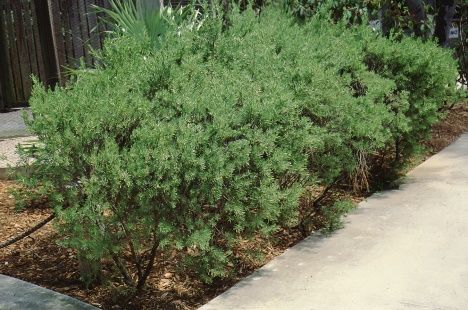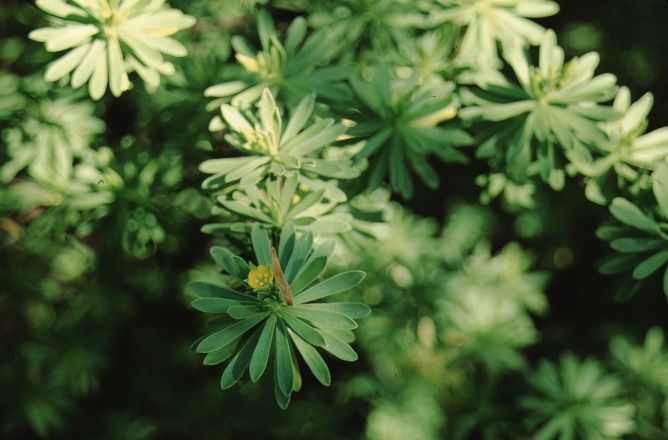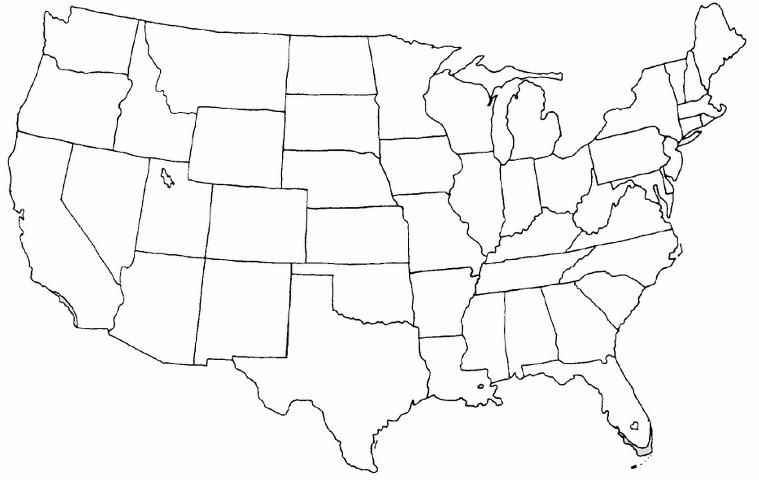Introduction
The bay cedar is endemic to south Florida, the Caribbean, Central America, and the Bahamas. It was commonly found growing in thickets, on sand dunes and rocky shores, often just back of the high tide line, but is now on the endangered plants list. This 5- to 20-foot-tall plant has a sturdy, branched trunk that has beautiful, dark brown, rough, flaky bark; the wood of this tree is very hard and heavy. Branches arch gracefully and hold the evergreen leaves on short, upturned twigs. The tiny, gray-green leaves are fleshy and minutely downy; the new leaves and twigs are particularly downy. Yellow, cup-shaped flowers may occur singly or in clusters that are inconspicuously set among the leaves. These small flowers occur consistently throughout the year. The seeds of the bay cedar are held in a small, brown, five-pointed calyx.

Credit: Edward F. Gilman, UF/IFAS

Credit: Edward F. Gilman, UF/IFAS
General Information
Scientific name: Suriana maritima
Pronunciation: ser-ree-AY-nuh muh-RIT-tim-muh
Common name(s): bay cedar
Family: Surianaceae
Plant type: shrub
USDA hardiness zones: 10B through 11 (Figure 3)
Planting month for zone 10 and 11: year-round
Origin: native to Florida
Invasive potential: not known to be invasive
Uses: container or above-ground planter; superior hedge; mass planting; recommended for buffer strips around parking lots or for median strip plantings in the highway; border; attracts butterflies
Availability: somewhat available, may have to go out of the region to find the plant

Credit:
Description
Height: 5 to 20 feet
Spread: 5 to 8 feet
Plant habit: oval
Plant density: dense
Growth rate: moderate
Texture: fine
Foliage
Leaf arrangement: alternate
Leaf type: simple
Leaf margin: entire
Leaf shape: spatulate
Leaf venation: none, or difficult to see
Leaf type and persistence: evergreen
Leaf blade length: less than 2 inches
Leaf color: green
Fall color: no fall color change
Fall characteristic: not showy
Flower
Flower color: yellow
Flower characteristic: flowers periodically throughout the year
Fruit
Fruit shape: round
Fruit length: less than 0.5 inch
Fruit cover: dry or hard
Fruit color: brown
Fruit characteristic: attracts birds
Trunk and Branches
Trunk/bark/branches: typically multi-trunked or clumping stems; showy
Current year stem/twig color: brown
Current year stem/twig thickness: medium
Culture
Light requirement: plant grows in full sun
Soil tolerances: acidic; alkaline; sand; loam
Drought tolerance: high
Soil salt tolerances: good
Plant spacing: 36 to 60 inches
Other
Roots: usually not a problem
Winter interest: no special winter interest
Outstanding plant: plant has outstanding ornamental features and could be planted more
Pest resistance: no serious pests are normally seen on the plant
Use and Management
Bay cedar is not commonly used in the landscape but could function as a specimen or border plant in beach locations. It has been used as a hedge because it responds well to clipping. Left to grow on its own, bay cedar can be trained into a small tree for a specimen planting in the landscape or in a container. Planted in a row on 5- to 6-foot centers, it functions as a screen.
Bay cedar has a high tolerance for salt and wind and is ideal for coastal landscapes. It will grow well in well-drained, sandy soils without irrigation once established and needs to be placed in a mostly sunny location.
Bay cedar is currently propagated by seed.
Pest and Diseases
No pests or diseases are of major concern.